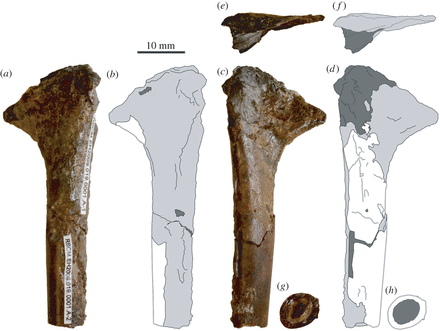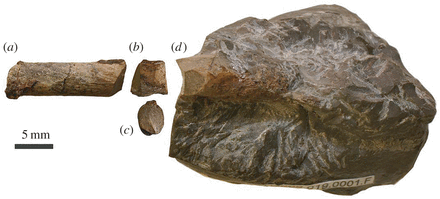A rare small-bodied pterosaur, a flying reptile from the Late Cretaceous period approximately 77 million years ago, is the first of its kind to have been discovered on the west coast of North America.
Pterosaurs are the earliest vertebrates known to have evolved powered flight.
The specimen is unusual as most pterosaurs from the Late Cretaceous were much larger with wingspans of between four and eleven metres (the biggest being as large as a giraffe, with a wingspan of a small plane), whereas this new specimen had a wingspan of only 1.5 metres.

Photographs and interpretative drawings of RBCM.EH.2009.019.0001, element A, a left humerus, in (a,b) dorsal, (c,d) ventral, (e,f) proximal and (g,h) distal aspect. Shading denotes preserved bone cortex (white); weathered bone (light grey) and matrix (dark grey)
The fossils of this animal are the first associated remains of a small pterosaur from this time, comprising a humerus, dorsal vertebrae (including three fused notarial vertebrae) and other fragments. They are the first to be positively identified from British Columbia, Canada and have been identified as belonging to an azhdarchoid pterosaur, a group of short-winged and toothless flying reptiles which dominated the final phase of pterosaur evolution.
Previous studies suggest that the Late Cretaceous skies were only occupied by much larger pterosaur species and birds, but this new finding, which is reported in the Royal Society journal Open Science, provides crucial information about the diversity and success of Late Cretaceous pterosaurs.

Photographs and interpretative drawings of RBCM.EH.2009.019.0001 vertebral material. (a–h) Element C, fragment of notarium in (a,b), lateral; (c,d), dorsal; (e,f), ventral and (g,h), anterior aspect; (i–l) element D, partial dorsal vertebra in (i,j), dorsal and (k,l) posterior aspect; (m–p), element G, probable vertebral process, posterior(?) and (o,p), anterior(?) aspect; and (q–t) element E, two associated dorsal vertebrae in (q,r), dorsal and (s,t), anterior aspect (c, centrum; nc, neural canal; ns, neural spine; tp, transverse process). Approximate junctions between vertebrae of element C are indicated by dotted lines.
Lead author of the study Elizabeth Martin-Silverstone, a Palaeobiology PhD Student at the University of Southampton, said: “This new pterosaur is exciting because it suggests that small pterosaurs were present all the way until the end of the Cretaceous, and weren’t outcompeted by birds. The hollow bones of pterosaurs are notoriously poorly preserved, and larger animals seem to be preferentially preserved in similarly aged Late Cretaceous ecosystems of North America. This suggests that a small pterosaur would very rarely be preserved, but not necessarily that they didn’t exist.”
The fossil fragments were found on Hornby Island in British Columbia in 2009 by a collector and volunteer from the Royal British Columbia Museum, who then donated them to the Museum. At the time, it was given to Victoria Arbour, a then PhD student and dinosaur expert at the University of Alberta. Victoria, as a postdoctoral researcher at North Carolina State University and the North Carolina Museum of Natural Sciences, then contacted Elizabeth and the Royal BC Museum sent the specimen for analysis in collaboration with Dr Mark Witton, a pterosaur expert at the University of Portsmouth.

Photographs of unidentified material of RBCM.EH.2009.019.0001, mostly comprising internal moulds of a long bone. (a) element B; (b,c) element H in lateral(?) and anterior(?) aspect; (d) element F.
Dr Witton said: “The specimen is far from the prettiest or most complete pterosaur fossil you’ll ever see, but it’s still an exciting and significant find. It’s rare to find pterosaur fossils at all because their skeletons were lightweight and easily damaged once they died, and the small ones are the rarest of all. But luck was on our side and several bones of this animal survived the preservation process. Happily, enough of the specimen was recovered to determine the approximate age of the pterosaur at the time of its death. By examining its internal bone structure and the fusion of its vertebrae we could see that, despite its small size, the animal was almost fully grown. The specimen thus seems to be a genuinely small species, and not just a baby or juvenile of a larger pterosaur type.”

Artist impression of the small-bodied, Late Cretaceous azhdarchoid pterosaur from British Columbia. These flying reptiles are shown here not surrounded not by other pterosaurs, but birds. Some researchers have argued that small pterosaurs were ecologically replaced by birds by the Late Cretaceous, but the discovery of new, small-bodied pterosaur remains from British Columbia shows that at least some smaller flying reptiles lived alongside ancient birds. .Credit: Dr Mark Witton
Elizabeth Martin-Silverstone added: “The absence of small juveniles of large species — which must have existed — in the fossil record is evidence of a preservational bias against small pterosaurs in the Late Cretaceous. It adds to a growing set of evidence that the Late Cretaceous period was not dominated by large or giant species, and that smaller pterosaurs may have been well represented in this time. As with other evidence of smaller pterosaurs, the fossil specimen is fragmentary and poorly preserved: researchers should check collections more carefully for misidentified or ignored pterosaur material, which may enhance our picture of pterosaur diversity and disparity at this time.”
Citation: University of Southampton. “A rare small specimen discovered from the age of flying giants.” ScienceDaily. ScienceDaily, 30 August 2016. <www.sciencedaily.com/releases/2016/08/160830211643.htm
Key: WFS,World Fossil Society,Riffin T Sajeev,Russel T Sajeev



 September 1st, 2016
September 1st, 2016  Riffin
Riffin  Posted in
Posted in  Tags:
Tags: 